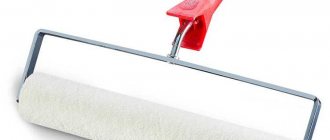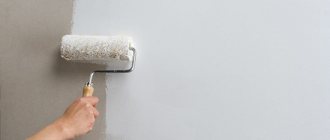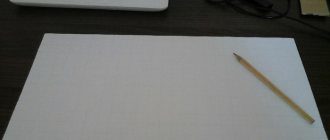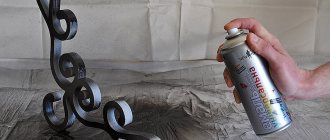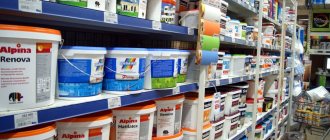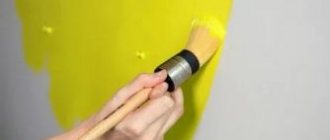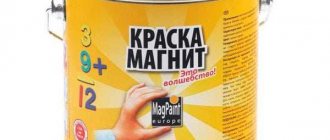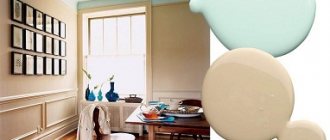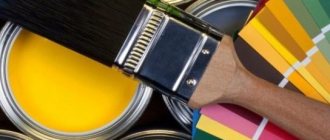How long does paint take to dry? This is one of the first questions when doing a renovation: how long will you have to wait until the paint layer dries and you can continue working? After choosing colors and the desired saturation of the colorful finish, as well as the most spectacular combinations and original decors, you have to return to practical reality and re-read the instructions on the paint can to decide how long this paint will dry. After all, until the paint layer has hardened, particles of debris and dust, inevitable during repairs, may stick to it - and then the anticipated aesthetics will end. In addition, it is rare that any paint is applied in one layer; usually, to create a dense monolithic coating, two or three, or even more layers are required, and here the question of the drying time of the paint comes to the fore. From experience, many people remember the approximate drying times for paint: nitro enamel can dry in half an hour to an hour, but it will harden completely only after half a day.
From complex repair experience: the more harmful the paintwork, the faster it dries on the base. Although there are exceptions - for example, modern environmentally friendly rubber paints provide a drying time of only one to two hours, without any odor or risk of allergies.
Features of application
You can paint almost any surface, however, due to the high water content, water-based emulsion is not used for painting metal and ceramics, since it will simply drain from these materials.
Most often, however, it is used for coloring streams. When using this coating, you can get both a matte and glossy finish. You can find out about the type of coating by special markings on the packaging.
After this, it is recommended to prime the surface well. This simple step will help reduce paint consumption and remove excess dust. After this, you can start painting in any convenient way.
Flow calculation
In terms of its composition, the coloring matter is a suspension. Its peculiarity is the rapid evaporation of water, after which a protective film is formed on the surface. Thanks to this, painting ceilings with water-based paint becomes quite durable, reliable and able to withstand increased moisture. This refers to a formulation that does not contain polyvinyl acetate (PVA). Environmentally friendly material that does not emit harmful substances and does not cause allergies.
Water-based paint fits perfectly on any surface. The product consumption depends on the quality of the applied layers. Manufacturers indicate the optimal rate in the instructions. For 10 m² you will need 1 liter of paint. To avoid overspending, the following recommendations should be followed:
- You cannot use thick paint in hopes of covering the ceiling with one coat. It is diluted with water and three thin layers are applied.
- Each subsequent painting is carried out after the previous one has completely dried.
- This coloring composition has a unique ability to be absorbed into any surface, so you will need to apply an additional layer. This can be avoided if the ceiling is carefully primed.
What is good about water emulsion?
Water-based (or, as it is also called, water-dispersion) paint consists of mineral or synthetic suspensions and coloring pigments dissolved in water. More precisely, paint particles do not dissolve in water, they simply mix with it, forming a homogeneous solution.
The properties and quality of the dye depend on these additives. So, for example, a washable water-based emulsion should contain water-repellent particles, while abrasion-resistant emulsion should contain hard and durable substances.
Water-based paint is increasingly being chosen for painting walls and ceilings in living rooms, offices, restaurants and other premises. This popularity is facilitated by the qualities of this material, such as:
- Good adhesion. The dye adheres reliably to the base material. As a result, the paint layer lasts for a long time, and bubbles and peeling areas do not appear on the walls. Concrete, wood, plaster, metal and other mineral and synthetic surfaces can be painted with VD dyes.
- Safety. The paint is absolutely non-toxic, it does not contain volatile substances, because it is based on water. The dye does not cause allergies and does not release toxins even when heated. All living spaces can be painted with water-based emulsion, including bedrooms and children's rooms.
- Easy to apply. You can paint the walls with any convenient tool (roller, brush, etc.). The material lays down in an even and uniform layer. When using a primer, one coat of paint may be enough; with each subsequent layer, the shade of the walls becomes richer and brighter.
- Drying speed. It is only a couple of hours. Walls must be dried at room temperature, without additional heat sources.
- Fire safety. Unlike oil-based and alkyd enamels, water-based paints are not prone to flammability.
- Variety of shades. This is achieved through tinting - the required amount of coloring pigment is added to the white base paint. In this way, you can achieve the desired shade, rather than relying on the existing color scheme. But there are not only white, but also colored water-based emulsions on sale, which simplifies painting work.
- Durability. Depending on the composition of the water-based paint, the coating will last from 5 to 20 years without losing its original brightness and uniformity.
- Performance. They are at a high level - the walls can be washed, cleaned with abrasives or wiped with a dry cloth (this depends on the instructions on the paint label). There is paint that is washable, abrasion-resistant, and so on.
How many times should you paint the ceiling so that streaks are not visible?
Painting the ceiling is an important point in the renovation of any room.
Therefore, to avoid visible defects, you should prepare. How to choose tools and materials?
- The roller must pick up a sufficient amount of paint, so you should choose a roller with long pile.
- To evenly impregnate the roller, you will need a molar tray, with which it is rolled out for high-quality painting without streaks.
- It is recommended to use acrylic-silicone based water-based paint. Its advantage is the ability to wash the ceiling multiple times.
Which water emulsion is better to choose?
Today, four main types of water-based dyes are in great demand:
- Acrylic. The basis of this paint is acrylic resins. and substances provide the dye with plasticity and resistance to mechanical stress. The thickness and density of acrylic water-based emulsion allows you to mask small cracks on the surface (up to 1 mm in size). This composition is easy to apply to walls, does not flow, dries quickly, and has no odor, which makes it possible to paint walls in living rooms and enclosed spaces. The acrylic coating dries in a few hours, after which a second layer can be applied. There are a lot of colors on sale, with their help you can achieve a unique shade or create your own palette. Acrylic water-based emulsion is washable, the walls will withstand up to 5 thousand wet cleanings without losing color and texture. The coating is not so easy to damage or scratch, so acrylic paints can be used in offices, shopping pavilions and other crowded places.
- Silicone. The paint consists of silicone resins. Elastic substances help the paint to lay down in an even and dense layer; you can even paint the walls with one layer of silicone water-based emulsion. This material is also quite plastic - it will fill cracks up to two millimeters wide, so you can do without preliminary plastering and priming. The cost of silicone paint is quite high, but it is considered very durable - the walls will remain beautiful for ten years. The main advantage of silicone water emulsion is vapor permeability. Microscopic pores in the paint coating will remove moisture from the surface and allow the walls to “breathe.” This paint can be applied to brick, concrete, plaster, wood and other mineral surfaces - mold, sweat and mildew will not appear on the walls. Most often, walls of bathrooms, kitchens and basements are treated with silicone paints.
- Silicate. These dyes contain liquid glass. By combining with water and colored pigments, silicate turns into a thick and uniform paint. The coating forms a durable and dense film on the walls, capable of allowing air to pass through and repel moisture. The layer of silicate water emulsion is so strong that it can withstand both mechanical stress and atmospheric conditions. The coating can be applied both indoors and on the external walls of the house. Paint durability is guaranteed for up to 20 years, and it costs less than silicone and acrylic dyes.
- Mineral water dispersion. This paint is the most affordable option in terms of price. It consists of slaked lime and a share of cement, and is tinted with special pigments. The layer of this dye is quite thin; it needs to be applied in several layers. Mineral water emulsion is suitable only for interior work - it is environmentally friendly, but not washable, as it does not repel water. So that the walls can be washed, after painting they can be opened with a moisture-repellent varnish.
To choose the right emulsion, you need to know about all its qualities. This information can be easily found on the material can. They indicate not only the purpose of the dye (for interior or exterior use, for wet or dry rooms), but also give recommendations on the care of painted surfaces, tinting and application.
So, for a bathroom or kitchen it is better to “fork out” for silicone dye. For the bedroom, living room or hallway, choose acrylic water-based paint - it can be cleaned and washed. But for a children's room, mineral paint will be the safest - although it is not very resistant, it will easily withstand several years of use (renovations in a child's room are most often done, because with age the child changes his tastes and preferences). It is better to treat the most difficult areas and corners of the house with silicate dyes - they are the most durable and resistant.
Leveling the ceiling surface and priming it
If the ceiling is fairly level and even with side lighting there are no significant surface defects, the steps below are necessary.
- Coat the ceiling with a penetrating primer. In this case, it is better to use a brush so as not to miss a single depression or irregularity.
- After the primer has dried, remove any unevenness with finishing gypsum putty.
- After 5-8 hours, level the putty areas, first with a coarse and then with a fine mesh grout.
- Prime the leveled putty areas.
Primer of leveled putty areas
If cracks have formed at the joints of the slabs , and the old plaster is crumbling, then the algorithm will be slightly different.
- Clean down to concrete using a spatula or hammer drill. There will be less dust if the surface is pre-moistened.
- Coat with penetrating primer.
- Re-plaster, checking the quality of work with a level and a steel meter. Cover the filled cracks in the joints with reinforcing mesh.
- After a day, putty and finally level the surface with trowel mesh.
Gluing serpyanka mesh to the ceiling
After leveling is completed, the surface is primed with water-based paint diluted with water.
How else are water-based paints classified?
In addition to the chemical composition, dyes also differ in texture. There are coatings that are applied in a thin and even layer, and there are paints that give texture and three-dimensional patterns. Such coatings are quite viscous and thick; they are applied with special textured rollers or sponges.
In addition, there are water-based emulsions:
- matte;
- glossy;
- semi-matte;
- semi-gloss.
When choosing a coating, you need to proceed not only from aesthetic considerations, but also take into account its practicality. For example, glossy walls are good where frequent cleaning is required - in kitchens, hallways and bathrooms. You should not use matte paint there, since by wiping certain places it can easily be “greasy” - sanded to a shine.
Surface preparation
The even, monochromatic coating provided by water-based paint compositions does not hide, but, on the contrary, makes all surface defects, irregularities and stains more noticeable. Therefore, the ceiling must be carefully prepared before painting.
Removing the previous coating
First of all, you need to cover the floor and the remaining furniture in the room.
Then, if the ceiling was whitewashed, you should:
- Gradually, in squares, moisten the old whitewash with a sponge and warm soapy water;
- remove the soaked layer with a spatula, placing a tray in order to stain the floor less;
- finally wash off the previous coating with a sponge.
If there is old water-based paint on the ceiling, it will not be possible to wash it off . You should at least remove this coating where it has peeled off.
To identify and eliminate all such areas, you need to:
- moisten the ceiling generously with a roller;
- let the water soak in thoroughly;
- open the windows and doors and create a draft in the room;
- Use a spatula to remove the old water-based coating from all areas where it has peeled off as a result of this procedure.
Removing old peeling paint
Special processing
If there are rusty spots or dark streaks, they are covered with one of the following compounds:
- 3% hydrochloric acid;
- thick lime “milk” with 50 ml of denatured alcohol;
- 5% copper sulfate;
- 20 parts crushed lime with one part drying oil.
If there is black mold (a common occurrence in kitchens and bathrooms, and other damp areas), you need to follow these steps.
- Strip the plaster down to the concrete. To reduce dust, it should be moistened first.
- Treat the concrete surface with an antiseptic primer. A budget alternative is a detergent containing chlorine, for example, “Belizna”.
- Cover the problem area with a penetrating primer and re-plaster it.
Special ceiling treatment: 1. Stripping down to concrete. 2. Applying an antiseptic primer. 3. Plastering.
Manual mixing
The manual method involves mixing pigment and paint yourself, at home, based on the manufacturer’s recommendations. The advantages of hand tinting paint include:
- Financial savings;
- The paint color can be diluted at the repair site;
- You can create unique color schemes.
However, this method has a disadvantage: it is impossible to recreate the resulting shade.
The manual method involves mixing pigment and paint yourself, at home, based on the manufacturer’s recommendations.
Benefits of tinting
Even a person who has never held a brush or roller before can handle painting walls and mixing colors. The main thing is to first correct the relief of the walls and prime them. This will eliminate the appearance of unevenness. After this you can do tinting. The main advantage of tinting is the ability to create the shade of color from the palette that is necessary for the room. Even an insignificant difference in shades will turn into a big problem. To avoid this, it is better to try out a new shade on a small area of the wall. This type of painting ennobles the room, more than wallpapering. Tinting is an opportunity to save a little on repairs; many cans with a paint base can be coated with pigment. In addition, the color may not pose a threat to health. Kohler will come to the rescue when you run out of paint of the desired shade, but the supermarket doesn’t have it either. Then you need to create a suitable color.
Pay attention to: Methods of painting a brick wall on a balcony
Coloring on a professional device
Using computer tinting, you can ensure that white paint acquires the desired shade in a short period of time, which is especially important if a large volume of paint and varnish is used. Using a color chart will greatly simplify the process. In addition, if necessary, the desired color can be repeated exactly. However, this method cannot obtain results at the repair site. In addition, it is impossible to create a unique color scheme by machine.
The tinting system consists of white paint, pigment, dispenser, construction shaker and computer program. The entire work process is carried out automatically.
Using computer tinting, you can ensure that white paint acquires the desired shade in a short period of time.
